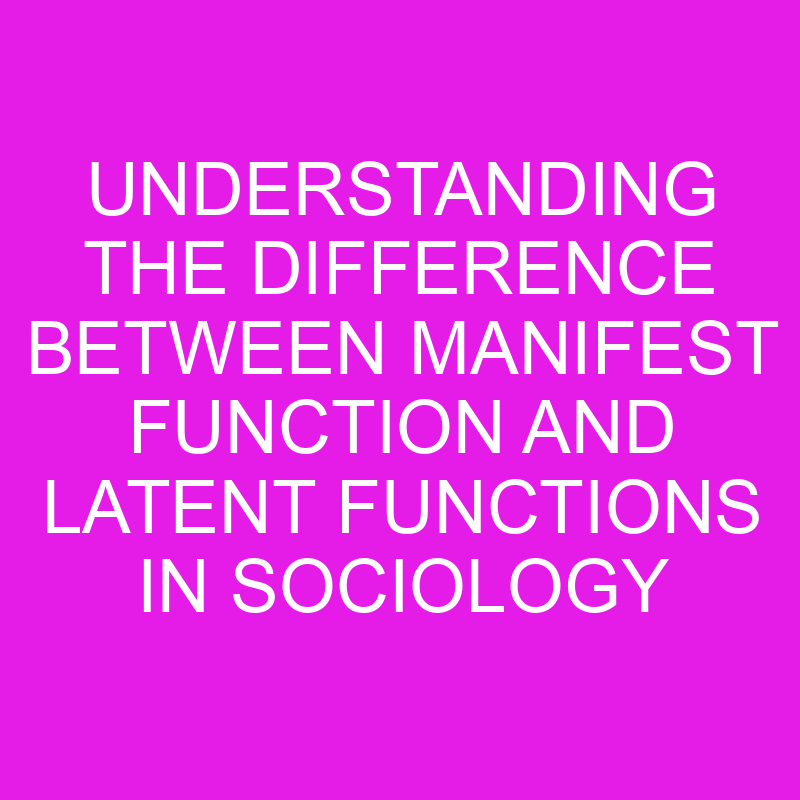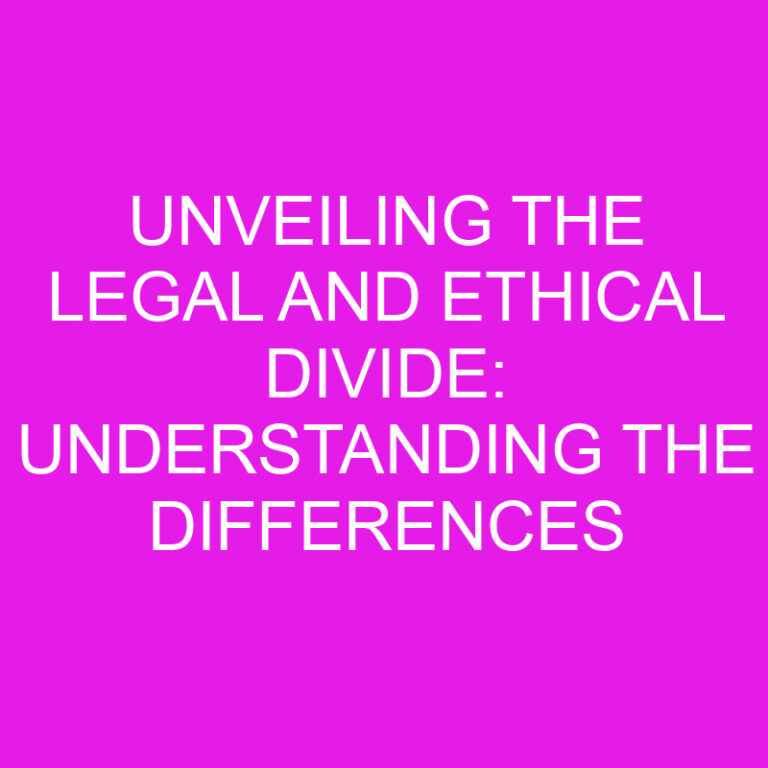
Have you ever wondered about the hidden purposes behind the things we do? Well, in the world of sociology, there are two important concepts that shed light on this phenomenon – manifest function and latent functions. Understanding the difference between these two can provide valuable insights into the underlying motivations and consequences of our actions.
Manifest function refers to the intended and recognized consequences of a social phenomenon. It’s like the primary purpose that is easily visible and acknowledged by society. For example, the manifest function of education is to provide knowledge and skills to individuals, enabling them to succeed in their careers and contribute to society. It’s the overt goal that everyone is aware of.
On the other hand, latent functions are the unintended and often unrecognized consequences of a social phenomenon. These functions are not explicitly stated or intended, but they still have an impact on individuals and society as a whole. Going back to the example of education, a latent function could be the development of social skills and networks among students, which can later help them in their personal and professional lives.
In this article, we will delve deeper into the difference between manifest function and latent functions, exploring their characteristics, examples, and significance in understanding the complexities of social interactions. So, let’s unravel the hidden layers and discover the fascinating world of manifest and latent functions together.
Post Contents
Key Takeaways
- Manifest functions refer to the intended and recognized consequences of a social phenomenon, while latent functions are the unintended and often unrecognized consequences.
- Manifest functions are deliberate, recognized, direct, planned, and generally seen as positive, while latent functions are unintentional, unrecognized, indirect, unplanned, and can have varied consequences.
- Manifest functions have clear goals and intentions, explicit planning and design, direct impact on individuals and society, and formal recognition.
- Understanding the significance of manifest functions helps analyze and interpret the function and impact of various social phenomena.
- Latent functions are important to uncover unintended consequences, challenge assumptions, identify hidden social dynamics, aid in planning and intervention, and adapt to societal changes.
- Recognizing and studying latent functions allows for a deeper understanding of how society functions and how individuals are influenced.
Characteristics of Manifest Function
When it comes to understanding social interactions, it is important to delve into the characteristics of both manifest and latent functions. In this section, I will focus on the characteristics of manifest function, which refers to the intended and recognized consequences of a social phenomenon. Let’s take a closer look at what sets manifest functions apart:
1. Intentionality: Manifest functions are deliberate and purposeful. They are the desired outcomes or goals that are planned or intended by individuals or institutions. For example, in the context of education, the primary and manifest function is to impart knowledge and skills to students.
2. Recognized: Manifest functions are widely acknowledged and accepted as the main purpose or objective of a social phenomenon. They are typically overt and visible to both the participants and the observers. In the case of education, the imparting of knowledge and skills is recognized as the primary function by students, teachers, parents, and society as a whole.
3. Direct and Clear: The consequences of manifest functions are directly connected to the initial action or purpose. They are easily identifiable and can be traced back to the specific way in which the social phenomenon was intended to operate. In education, for example, students directly benefit from the knowledge and skills they acquire, which can enhance their academic and professional prospects.
4. Planned Outcomes: Manifest functions are usually a result of conscious planning and organization. Institutions and individuals put in effort and resources to achieve these intended outcomes. In the case of education, curriculum development, instructional design, and assessments are all planned with the aim of ensuring the successful realization of the manifest function.
5. Positive Consequences: Manifest functions are generally seen as beneficial and positive in nature. They contribute to the overall functioning and stability of society by serving the needs and goals of individuals and institutions. For example, education’s manifest function of imparting knowledge and skills is vital for personal growth, workforce development, and societal progress.
Understanding the characteristics of manifest function helps us to navigate the complexities of social systems and interactions. By analyzing the intended and recognized consequences of various social phenomena, we can gain deeper insights into their functions and impact on individuals and society as a whole. Now that we have explored the key features of manifest functions, let’s move on to examining latent functions in the next section.
Characteristics of Latent Functions
Latent functions, unlike manifest functions, are the unintended, unrecognized consequences of a social phenomenon. These functions are not initially planned or intended, but they still play a crucial role in shaping social systems and interactions. Understanding the characteristics of latent functions can help us gain insights into the hidden dynamics of social phenomena. Here are some key characteristics:
- Unintentionality: Latent functions are not consciously planned or intended. They emerge as a byproduct of the manifest functions and are often overlooked or not recognized by individuals involved in the social phenomenon.
- Unrecognition: Unlike manifest functions, latent functions are not immediately recognized or acknowledged by individuals. They may remain hidden or only become apparent over time, as their impact on society becomes more evident.
- Indirectness: Latent functions operate indirectly and operate in a manner that is not directly connected to the primary purpose or intention of the social phenomenon. They can have a significant impact on social structures, even if their connection is not obvious.
- Unplanned outcomes: Latent functions result in outcomes that are not explicitly planned for. They may arise spontaneously or through unintended consequences, influencing social systems and individuals in unexpected ways.
- Varied consequences: The consequences of latent functions can be both positive and negative. While some latent functions may have positive effects on society, others can lead to unintended negative outcomes, such as inequality or social tensions.
Understanding the characteristics of latent functions allows us to look beyond the surface-level functions of social phenomena. By recognizing the unintended consequences and hidden dynamics, we can gain a deeper understanding of how societies function and evolve over time.
Let’s now delve into some examples of latent functions to further illustrate these characteristics.
Examples of Manifest Functions
Now that we have a clear understanding of the concept of manifest function, let’s explore some examples to further illustrate this concept. Manifest functions are the intended and recognized consequences of a social phenomenon. These functions are purposeful and commonly agreed upon by members of a society.
- Education: The primary manifest function of education is to provide knowledge and skills to individuals. This includes teaching subjects such as math, science, and literature, as well as essential life skills like critical thinking and problem-solving. Additionally, education plays a crucial role in socializing individuals and preparing them for their future roles in society.
- Healthcare: The manifest function of healthcare is to promote and maintain the well-being of individuals. This includes providing medical treatment for illnesses and injuries, preventive care such as vaccinations and screenings, and promoting healthy lifestyles. Healthcare systems aim to improve the overall health of the population and ensure access to medical services for all.
- Transportation: The primary manifest function of transportation is to facilitate the movement of people and goods from one place to another. Whether it’s by road, air, rail, or sea, transportation systems play a vital role in connecting individuals and communities. They enable economic activities, enhance social interactions, and provide access to essential services.
- Law enforcement: The manifest function of law enforcement is to ensure public safety and maintain social order. Police officers, for example, are responsible for protecting citizens, preventing crime, and apprehending criminals. The justice system, with its courts and prisons, aims to enforce the laws and provide consequences for those who violate them.
- Economics: The manifest function of economics is to regulate and facilitate the production, distribution, and consumption of goods and services. This includes activities such as job creation, setting prices, managing finances, and promoting economic growth. Economics plays a fundamental role in shaping the overall well-being of societies.
These examples demonstrate how manifest functions are the intended and recognized purposes of various social phenomena. They showcase the specific goals and outcomes that are typically expected and agreed upon by members of a society. By understanding these examples, we can gain a deeper insight into how social systems and institutions function and contribute to the overall fabric of our communities.
Examples of Latent Functions
Now that we have discussed the characteristics of latent functions, let’s delve into some examples to further illustrate this concept. These examples will give you a clearer understanding of how latent functions can shape and influence various aspects of society.
- Social Media: While the manifest function of social media might be to connect people and share information, it also serves several latent functions. For example, social media platforms inadvertently provide a platform for cyberbullying and online harassment. These negative consequences are unplanned and unintended, but they are an unfortunate reality of the digital age.
- Gated Communities: Gated communities are designed with the manifest function of providing residents with a safe and secure living environment. However, they also serve latent functions such as social exclusion and the perpetuation of social inequalities. By creating physical barriers and exclusive spaces, these communities unintentionally contribute to the division and segregation within society.
- Political Campaigns: While the manifest function of political campaigns is to persuade voters and win elections, they also have latent functions. Political campaigns can help raise awareness about important societal issues and engage citizens in the political process. Additionally, they can foster a sense of community and collective identity among supporters of a particular candidate or party.
- Fashion Trends: Fashion trends often have a manifest function of expressing individual style and reflecting current cultural aesthetics. However, they can also serve latent functions such as social conformity and the reinforcement of social norms. By following popular fashion trends, individuals inadvertently conform to societal expectations and reinforce established standards of beauty and style.
- Natural Disasters: While the manifest function of natural disasters is to cause destruction and loss, they can also have latent functions. Natural disasters can bring communities together, fostering a sense of solidarity and cooperation. They can reveal the strength and resilience of individuals and societies, leading to the formation of new social bonds and the development of disaster preparedness measures.
These examples demonstrate the complexity of social phenomena and highlight how latent functions can have both positive and negative impacts on society. By understanding the latent functions of various social phenomena, we can gain a more comprehensive understanding of how individuals, groups, and communities interact and shape the world around them. Keep in mind that these examples are just a starting point, and there are countless other instances of latent functions in our everyday lives.
Significance of Manifest Function
Manifest functions play a significant role in the functioning of social systems and interactions. These functions are the intended consequences of a social phenomenon and are often explicitly stated or recognized. In other words, they are the overt and purposeful outcomes of an action, institution, or behavior. Understanding the significance of manifest functions helps us better comprehend the functioning and impact of various social phenomena. Here are a few key points about the significance of manifest functions:
- Clear goals and intentions: Manifest functions are easily identifiable because they are the intended goals or purposes of a social phenomenon. They provide a clear understanding of why certain actions or institutions exist and how they contribute to the overall functioning of society.
- Explicit planning and design: Manifest functions are usually a result of explicit planning and deliberate design. They often involve conscious decision-making by individuals, groups, or institutions to achieve certain objectives. This level of intentionality distinguishes manifest functions from latent functions.
- Direct impact on individuals and society: Manifest functions have a direct and immediate impact on individuals and society as a whole. They are designed to fulfill specific needs, solve problems, or achieve desired outcomes. When manifest functions are successfully carried out, they contribute to the overall stability and functionality of social systems.
- Formal recognition: Manifest functions are often formally recognized and acknowledged by individuals or society as a whole. They are typically part of official plans, policies, or goals, and are key drivers of social change and progress.
Understanding the significance of manifest functions is crucial for sociologists and researchers as it helps them analyze and interpret the function and impact of various social phenomena. By studying manifest functions, we can gain valuable insights into the motivations, goals, and intentions that shape social structures and interactions.
Please continue reading for more information about latent functions.
Significance of Latent Functions
While manifest functions are important in understanding the intended consequences of a social phenomenon, it is equally crucial to recognize the significance of latent functions. Latent functions refer to the unintended and often unrecognized consequences that result from a social phenomenon. These functions may not have been explicitly intended or planned, but they still contribute to shaping society and individuals in various ways.
One of the key aspects of latent functions is their indirect and subtle nature. Unlike manifest functions, which have explicit goals and intentions, latent functions operate beneath the surface and are not immediately visible or recognized. They can emerge organically from social interactions, cultural practices, or even unintended side effects. Their impact may be less obvious, but it is no less significant.
Understanding the latent functions of social phenomena allows us to gain a deeper understanding of how society functions and how individuals are influenced. Here are a few reasons why recognizing and studying latent functions is important:
- Uncovering unintended consequences: By examining latent functions, we can uncover the unintended consequences of social phenomena that may go unnoticed. These consequences can have a profound impact on individuals and society as a whole.
- Challenging assumptions: Latent functions help us challenge existing assumptions and broaden our understanding of how various aspects of society are interconnected. They provide insights into the complexities of social interactions and their wide-ranging effects.
- Identifying hidden social dynamics: Latent functions reveal hidden social dynamics that shape the way we think, behave, and interact with one another. By recognizing these dynamics, we can better comprehend the underlying forces influencing our lives.
- Planning and intervention: Studying latent functions can inform effective planning and intervention strategies. By understanding the unintended outcomes of social phenomena, policymakers, organizations, and individuals can work towards creating positive change and addressing negative consequences.
- Adapting to societal changes: Recognizing latent functions helps us adapt to societal changes. As social contexts evolve, understanding the unintended consequences allows us to adapt and respond to the shifting dynamics and challenges faced by individuals and communities.
Conclusion
Understanding the concepts of manifest function and latent functions in sociology is crucial for comprehending the functioning and impact of various social phenomena. Manifest functions, which are the intended consequences of a social phenomenon, have clear goals and intentions and have a direct impact on individuals and society. On the other hand, latent functions, the unintended consequences, operate beneath the surface and are not immediately visible or recognized.
By recognizing and studying both manifest and latent functions, we can uncover unintended consequences, challenge assumptions, identify hidden social dynamics, plan interventions, and adapt to societal changes. This knowledge helps us better understand how social phenomena shape various aspects of our lives and society as a whole.
Examples of both manifest and latent functions, such as social media, gated communities, political campaigns, fashion trends, and natural disasters, illustrate how these functions can have both positive and negative impacts on society.
Manifest and latent functions provide valuable insights into the complex dynamics of social phenomena, allowing us to navigate and understand the intricacies of society.
Frequently Asked Questions
Q: What are manifest functions?
Manifest functions are the intended consequences of a social phenomenon. They have clear goals and intentions, involve explicit planning and design, have a direct impact on individuals and society, and are often formally recognized.
Q: Can you give examples of manifest functions?
Examples of manifest functions include education, which aims to provide knowledge and skills to individuals; laws, which intend to maintain order and ensure justice in society; and healthcare systems, which seek to improve and maintain people’s health.
Q: What are latent functions?
Latent functions are the unintended and often unrecognized consequences that result from a social phenomenon. They operate beneath the surface and are not immediately visible or recognized, but they still contribute to shaping society and individuals in various ways.
Q: What are some examples of latent functions?
Examples of latent functions include social media, which can connect people and facilitate communication but also contribute to addiction and privacy concerns; gated communities, which provide security but may lead to social segregation; and fashion trends, which can foster self-expression and identity but also fuel consumerism and materialism.
Q: Why is understanding manifest and latent functions important?
Understanding manifest and latent functions helps us better comprehend the functioning and impact of various social phenomena. It allows us to uncover unintended consequences, challenge assumptions, identify hidden social dynamics, plan and intervene in a more informed manner, and adapt to societal changes.






